Crimping twisted pair 8 and 4 cores: basic schemes + step-by-step briefing of crimping
Computer networks are the traditional reality of modern digital technology. Similar structural elements are used universally and on a large scale. Meanwhile, the construction of networks involves the massive use of a special cable, through which individual points (nodes) are interconnected.
Such a cable is technologically seen as the standard version of products of this type, and a peculiar feature of the product is twisted pair - two conductors. These conductors are twisted with one another along the entire length, being insulated. In this case, a certain twisting step is observed.
We will talk about how twisted pair crimping is done to organize reliable contact. The article we presented describes the connection for a four-core (2 pair) and eight-core (4 pair) cable. Based on our advice, you can carry out the entire front of work yourself without any problems.
The content of the article:
Features of crimping a conductor of 8 and 4 cores
Before considering the crimping technology of copper conductors that make up the internal contents of a network cable, it is logical to familiarize yourself with the options for connecting the terminals.
Network cable lug crimping schemes
Ferrule - standard plastic plug of 8P8C series connector. Such a connector (plug + socket) is often classified by computer network connoisseurs as the RJ45 connector.
However, such a classification is incorrect. But this is for general information.

As can be seen from the designation of the series (8P8C), the plastic plug and socket are also 8-pin.These eight contacts can be connected in a different schematic form, depending on the type of cable connection.
Actually, there are two standards for the wiring of the conductors of the T568A and T568V plug and two options for crimping them:
- Straight.
- Cross.
For convenience twisted pair cable pinouts and subsequent crimping, each core is marked with a specific color. Moreover, the veins of one pair are close in color. For example, the classic coloring of the first pair for the T568A standard for direct crimping of the first twisted pair: 1 - green-white; 2 - green.
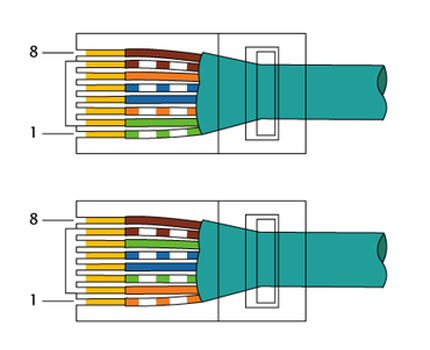
Direct and cross configuration
What is the difference between the direct and cross crimping schemes of copper conductors, should be obvious. The direct configuration provides a circuit solution when the two conductor numbers (colors) coincide on the two opposite ends of the network cable.
The cross configuration, respectively, provides a circuit solution, when at the opposite ends of the network cable there is a slightly changed scheme for the correspondence of conductors by numbers (colors) relative to each other. In particular, 1,2,3 and 6 conductors are interchanged.

Both crimping schemes provide for the location of conductors on opposite end plugs, taking into account the numbering, when the first wire is opposite the eighth and vice versa - the eighth wire is opposite the first.
In addition to these two schemes, there is another, called "console". In this case, the conductors along the end plugs are arranged in reverse order upside down.
That is, the first conductor of one plug corresponds to the first conductor of the other plug and, accordingly, the eighth wire at one end corresponds to the eighth wire at the opposite end.
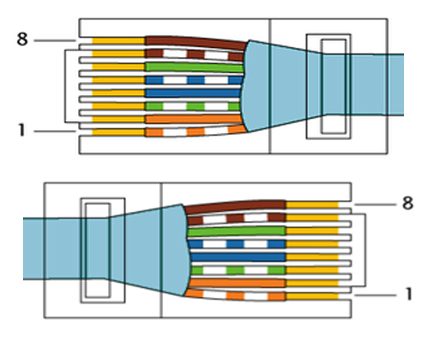
The purpose of a particular scheme
Specific application reviewed twisted pair crimping circuits determined by the options for connecting computer equipment. As a rule, direct configuration is used for connecting a network card and a switch (hub).
Cross configuration is usually used when there is a need to connect two network cards of personal computers. The same scheme was used for communications of outdated models of communicators (hubs).
It is worth noting an important detail: at the present stage of development of digital technology, the cross-configuration has practically lost its significance. This is due to the development and implementation of technology for automatic detection of signal circuits of network terminals.
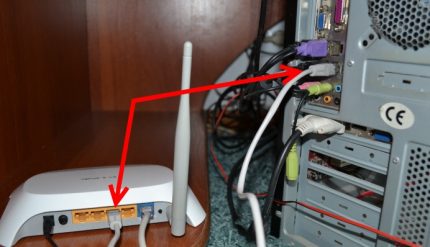
Step-by-step instructions for crimping the network cable
Given that cable connections are used quite often in a variety of conditions, including domestic, the question of how to compress a cable of 8 cores is quite relevant. Especially if not experts are taken into account, but ordinary users who own personal computers.
Consider this uncomplicated workflow to ease the task for potential creators of home networking.
For crimping work cable twisted pair need a special tool:
- crimper;
- stripper;
- ordinary knife.
The first two tools with exotic names are a special press reminiscent of ordinary electrician's pliers and a cutter for removing cable insulation.
In fact, the cutter is an ordinary knife, with the only difference being that it is equipped with additional notches for removing the insulation coating.
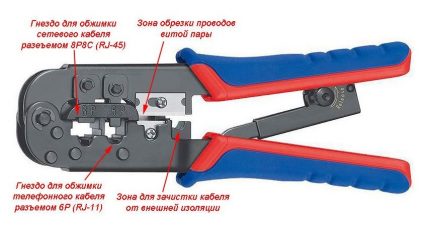
Step # 1 - preparing the cable
Here you will need to select the desired option according to the number of cores and the desired length. For home use, it is often necessary to crimp 4 wire twisted-pair copper, that is, you need a piece of cable for four wires.
In principle, the use of an eight-core cable version is also possible. In this case, idle pairs are simply not used. Another issue is saving, because the price of four-pair products is higher than two-pair ones.
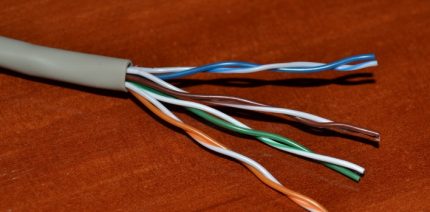
Step # 2 - trimming insulation
Having prepared a piece of the required length, it is necessary to carefully remove the insulation on the short end sections of the network cable. It is enough to step back 40-50 mm from the edge of the end cut, then cut the cable sheath with a light circular passage.
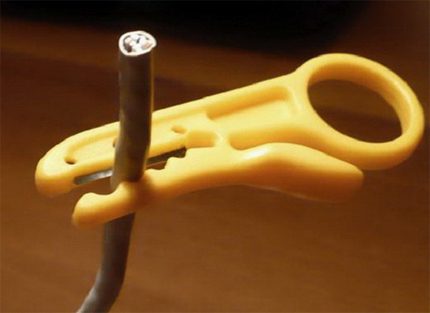
It is recommended to carefully perform this action so as not to touch the insulation of the internal conductors. Usually, the shell is not cut to the full depth, but only partially. Then, with a smooth movement of the hands, the cable is bent in the incision area, so that the shell is torn in a circle.
It is quite convenient and high-quality to remove the cable sheath using a stripper. However, before you have to spend some time mastering this tool. From the first call, it is rarely possible to perform a qualitative pick-up with a stripper, even for professionals.
Step # 3 - preparing the cores for loading the plug
The opened, twisted-pair conductors in the area freed from the insulating cable sheath should be untwisted (untwisted) and smoothed. Thin-insulated copper conductors are quite soft, so it’s easy to perform such actions.
Then all wires should be aligned relative to each other and cut exactly perpendicularly, departing from the end of 2-3 mm. This operation is conveniently performed with ordinary paper scissors. As a result, an even end row of four (or eight) copper insulated cores should form.
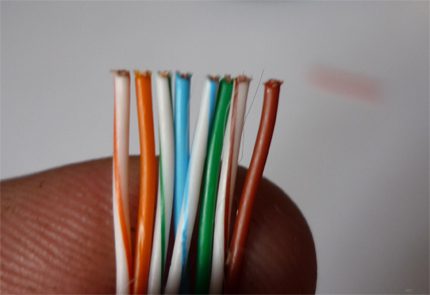
Next, a plastic new eight-pin plug (8P) will be used, on which crimping will be performed - contact fastening of copper conductors. It is worth considering that there are no 4-pin plugs for computer networks. Therefore, in any case, a 8-pin plug is used.
Step # 4 - crimping pads
The back of the plug (8P) is technically an input gateway for loading copper cores. A kind of gateway contains eight rectangular cells, where the corresponding color conductors are loaded.
The loading of copper conductors of the network cable into the “gateway” of the contact plug is carried out without removing the insulation. Wires are simply inserted into the channels until they stop.
Then a standard press is used for 8P8C connectors. The press block is superimposed on a plastic fork, after which the tool handles are compressed until a characteristic click occurs.
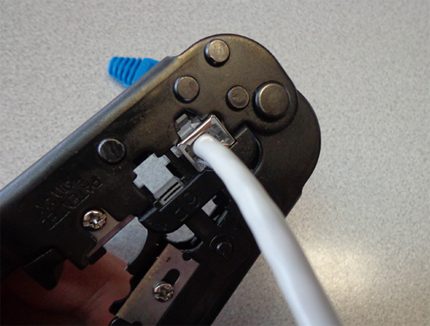
Step # 5 - press quality testing
After crimping, the press is removed, the connection is checked for strength by attempting to physically pull the conductors out of the plug. If everything is done exactly according to the technology, the crimping strength will not allow you to remove the cores from the pressed slots.
On this crimping procedure is considered complete. A similar process is carried out at the opposite end of the cable.
The end of the crimping of the two ends of the cable is usually followed by a subsequent electrical test. For this, a special tester is used, including a transmitter and a receiver of the test signal. The processed cable is included in the device and, using control LEDs, is tested for connection integrity.

Application of non-standard pressing methods
Given that acquiring a special tool (the same crimper) requires money, some craftsmen practice a non-standard method of crimping wires. Use an ordinary electrician screwdriver with a flat tip of suitable width and thickness.
Such a screwdriver makes the pressing of the contact rods, successively pressing one into the body of the plug one by one.

If it is required to perform twisted pair extension, work is performed in the order described in detail in the next article. We recommend that you familiarize yourself with useful informative material.
Conclusions and useful video on the topic
The video below demonstrates the household version of working with cable crimping, the use of a special tool and a step-by-step process.
This video, although not entirely correct in technical terms, will help to understand the essence of the process more fully.
The procedure for crimping copper cores of a network cable can be studied theoretically without much difficulty. Meanwhile, even with theoretical knowledge, a practical skill is required.
In fact, this skill is developed quickly enough even when you have to face work for the first time. True, in order not to spoil a couple of plastic forks, the novice master can not do - you will have to first practice. This is the law of practice.
Please leave comments, post photos and ask questions in the block below. Tell us about how you crimped a twisted pair with your own hands. Perhaps you know the tricks and techniques that will be useful to site visitors.

 RJ45 twisted pair cable pinout: wiring diagrams and crimping rules
RJ45 twisted pair cable pinout: wiring diagrams and crimping rules 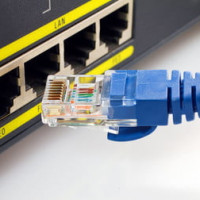 How to crimp an RJ-45 Internet cable with your own hands: ways + instructions for crimping an Internet connector
How to crimp an RJ-45 Internet cable with your own hands: ways + instructions for crimping an Internet connector 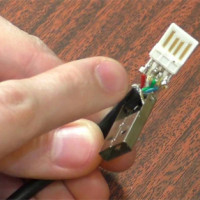 Pinout of different types of USB connectors: pinout of micro and mini usb contacts + nuances of desoldering
Pinout of different types of USB connectors: pinout of micro and mini usb contacts + nuances of desoldering 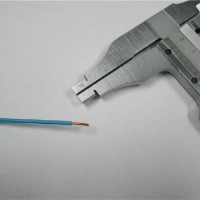 How to determine the cross-section of a wire by diameter and vice versa: ready-made tables and calculation formulas
How to determine the cross-section of a wire by diameter and vice versa: ready-made tables and calculation formulas 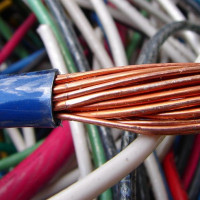 Types of cables and wires and their purpose: description and classification + decoding of marking
Types of cables and wires and their purpose: description and classification + decoding of marking 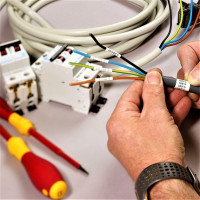 Colors of wires in electrics: standards and labeling rules + methods for determining the conductor
Colors of wires in electrics: standards and labeling rules + methods for determining the conductor  How much does it cost to connect gas to a private house: the price of organizing gas supply
How much does it cost to connect gas to a private house: the price of organizing gas supply  The best washing machines with dryer: model rating and customer tips
The best washing machines with dryer: model rating and customer tips  What is the color temperature of light and the nuances of choosing the temperature of the lamps to suit your needs
What is the color temperature of light and the nuances of choosing the temperature of the lamps to suit your needs  Replacement of a geyser in an apartment: replacement paperwork + basic norms and requirements
Replacement of a geyser in an apartment: replacement paperwork + basic norms and requirements